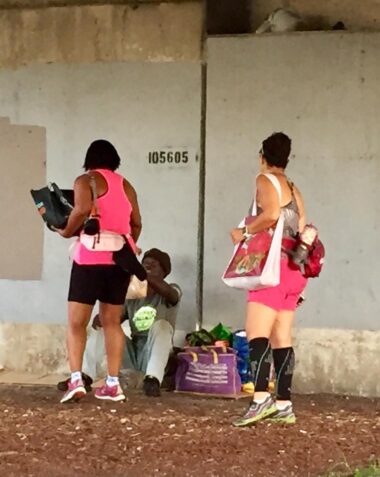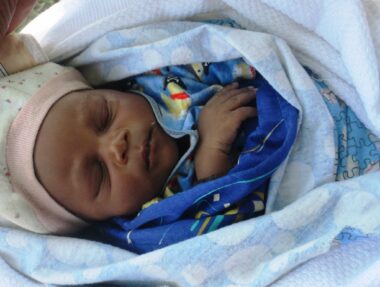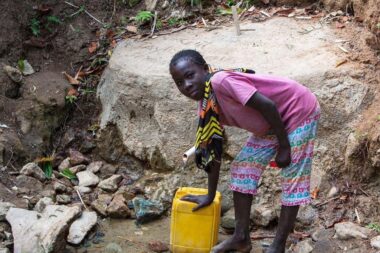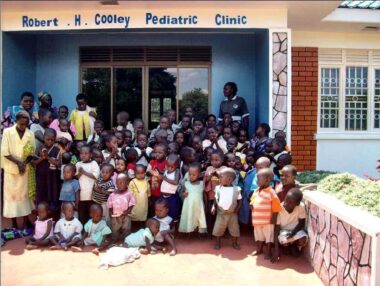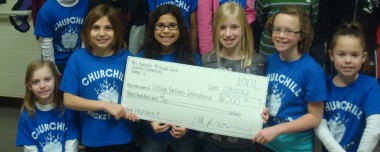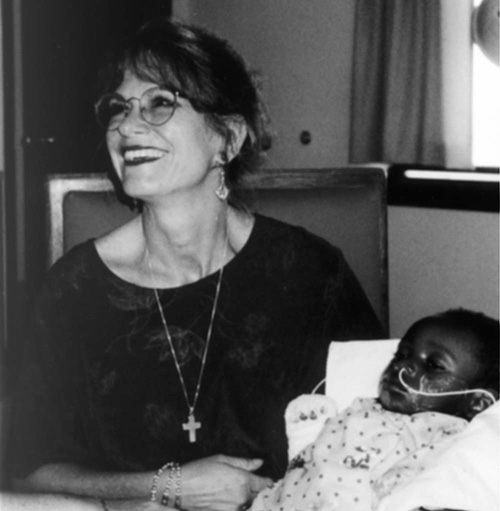
One Small Miracle in Haiti
Since 1995, a core group of volunteers led by Dr. Sylvia Campbell has traveled to the small Haitian mountain village of Mombin Crochu. Every trip is a new experience, each case a new challenge. Although no procedure is more important than another, upon occasion, an encounter sends them home never to be the same, for they have been touched by something much larger, much more complete. One such example is as follows.
One Small Miracle
Haiti is the poorest country in the Western Hemisphere. Poverty, starvation and death walk hand in hand with daily existence here, and life as we know it does not exist in the mountain villages. I know that we cannot change the politics, nor affect the turbulent nature of the government in this Caribbean nation. But, by touching one life, one child, perhaps we can send a message that others do care, and instill hope to those who suffer in a world that, in their eyes, has forgotten them. The following is one example.
It was early Tuesday morning, our fourth day in the tiny Haitian village of Mombin Crochu. We have traveled to this mountain village three times before, and have come to know the people as we step into their lives for a brief moment in time. For the villagers, electricity and running water are not part of daily existence, and food is cooked outside on charcoal fires. There is no infrastructure in this country, and things that we take so for granted are non-existent…therefore medical care is available only to those who can pay. In this remote area, a clinic is struggling to become reality, with the help of the Medical Benevolence Foundation of the Presbyterian Church. And it was here, in this environment, that a miracle unfolded.
It was our fourth day in Mombin Crochu. The heat and exhaustion were beginning to reach us, as we struggled to accomplish as much as possible in a short time. I was in the make-shift operating room, finishing a hernia repair, when the word arrived. A small baby had been badly burned by an open charcoal cooking fire (which are customary in the region) and had been carried by his mother up the mountain to the clinic.
I looked at the faces of the women who stood with me in the OR, and a shudder traveled through me. How could we possible care for this child here? How could we not?
An 18 month old infant, burned over 35-40% of his body, awaited us. He lay in his mother’s arms, and did not cry, but stared at us with empty eyes that spoke of unbearable pain. I wanted to cry, but could not…I knew how limited we were.
We had no lab, no xray, no general anesthesia…we had only our eyes, our ears, and our hearts…and the drugs that we had carried with us to this village. Reaching Mombin Crochu entails a flight from Tampa to Miami, Miami to Port-au-Prince…then a trip to the mission air field where one must board a single engine plane to fly to a grass air strip in the village of Pignon. There supplies and weary Americans are loaded onto a deuce-and-a-half truck and travel a harrowing 21/2 hour trip to reach our destination, 12 miles away.
But immediate care was necessary for this baby. We found a small foley, and placed it, and began giving him IV fluids based upon his urine output. We debrided his burns , trying to leave as much skin as possible in place to act as a dressing, using the silvadene that we had brought in our supplies. And we sedated him with the few drugs that we had.
We did not sleep that night, as we were the only ones to watch him. I tried to lie down for a few minutes, and a gentle knock came at the window of our room. The baby’s sister stood there, quietly begging us to help him, as he cried again. All we could really offer was sedation…. and prayers…
As we stood in the OR the next day, I looked at two of the nurses that had traveled with me, Maureen Doyle and Jeannie Hardin-Gres, and said “Our baby will die if we don’t get him to a burn unit. And he should be in a burn unit in the United States. He cannot survive the drive…so we just have to get a helicopter here!”
“Sure…no problem…”, they replied.
There were a few small problems, however. We had no phone, to begin with. And, as a hurricane had hit the island the week before we came, the antennae to the CB radio had been bent. Diana Hashaw, another nurse from Tampa, climbed the radio pole to straighten the antennae. I was scrubbed and could not believe it until I walked out and saw her suspended from the top of the pole.
We then placed a call, through Indiana, to Tampa, where we reached the Regional Medical Benevolence Foundation office…and an answering machine! Luckily, we were then able to reach my office and explain that we had to do this.
My staff, and especially Gloria Rogers, who worked incessantly on this project, were able to then contact the Medical Benevolence Foundation office, and Paul Read, the regional director. He then took up the charge, involving the United Nations and Customs. Calls were made to the United Nations in New York and Port-au-Prince, as well as the Immigration Authorities in Tampa, who agreed, finally, to grant the baby 90 days stay without papers.
The most difficult challenge, however, was talking to the baby’s family. They had never left his side, and had stood, wide-eyed, as we tried to do what we could for their child. I had to explain that I felt that he needed to travel away from the village, to a burn unit…a burn unit in America, where he could receive the care that might save his life. I also had to explain that it might not save his life…that he could possibly leave and never return, to die in a strange country away from those who loved him. But without trying he surely would die. Having three children of my own, and having lost my fourth child at birth, it was a very difficult and painful thing to say, yet it had to be said.
It took four hours for his family to decide that they would let us carry him away, to offer what hope, and help, we, strangers to them all, could offer. In this village of abject poverty, where shoes are not worn and starvation is rampant, the family brought a beautiful white outfit, covered in pearl buttons, with new shoes and socks, for him to wear on the plane to this new country. Seeing his tiny mother holding these clothes out to me was probably one of the hardest things I have had to face in my career; watching the pain in her eyes and understanding how much she loved her son…enough to let him leave. I explained that we could not put this outfit on him now, because of all the dressings, but that we would bring him back to her dressed in this beautiful white outfit.
Early the next morning, the small village gathered to draw a white circle surrounding an “H” in the middle of the empty space that served as “market” twice weekly. In this village, where travel is done by foot or donkey, the load roar of the machine broke the stillness as the U.N. helicopter landed.
Our little burned baby was wrapped in gauze and carried on a gurney to the village square, where the large white Russian helicopter stood waiting, the early morning sun glistening on its shining surface. Argentine medics jumped out, and we loaded the child onto the machine, as Jeannie, our nurse anesthetist, climbed in to travel with him. His mother kissed him goodbye, and stepped down, not knowing if she would see him again.
The heat of the early morning bore down upon us as we stood watching…and slowly, the silver bird rose from the red clay , carrying our precious cargo. The village gathered in a circle, held hands, and sang in Creole and English, “Take it to the Lord in Prayer”. And I cried for the first time.
Jeannie became our baby’s surrogate mother in the United States, where he was cared for at Tampa General Hospital’s Burn unit. Under the direction of Dr. Thomas Krizek, the Director of the Burn Unit, and Chairman, his residents and fellows, as well as the pediatric intensivists, Drs. Rick Weibly and Dr. Dan Riggs, he slowly improved.
Debridement of his burns required several trips to the operating room; however, luckily, no grafting was required. Problems of fluid resuscitation, electrolyte imbalance, and sepsis were treated accordingly, and, with the gradual lowering of his temperature, his lethargy began to improve. Initial nutrition was given with tube feedings, as he refused to eat. Once able, he did develop a true appreciation for milkshakes and fries!
He had a very difficult time at first, but, with the excellent care he received there, he was eventually able to heal and slowly recover from the trauma . Watching him in the Pediatric ICU, surrounded by all the technology of modern medicine, as Sesame Street and Big Bird ran across his TV, I wondered at the changes that he had witnessed in his short life…and I wondered and marveled at the miracle of his face, which, slowly, remembered how to smile.
Our baby’s burns were healed. In the process he had stolen the hearts of all who knew him , for his smile had become infectious, and his laughter, once begun, could not be stopped.
All of his bills were written off by the doctors who cared for him , and the hospital agreed to accept what we were able to raise in donations, to cover his costs. Just because it was the right thing to do.
We were able to bring our baby home to his family, traveling the route that had become familiar to us over the years. Watching his face, I wondered if he remembered any of the sounds that were surrounding us as we entered Port-au-Prince. I wondered at the pain in our hearts as we returned him to the village where he belonged. And, as we drove up, we placed the white outfit over his Jobst stockings, so that he could return to his family as we had promised. …………
That night, a double rainbow arched over the mission clinic in the mountains, speaking of all that was right here. For one brief moment, all of the forces of so many differing peoples had joined, to save the life of this small child.
I believe this truly is what we are here for. This truly is why we are in this profession. And I do believe that miracles do occur, if only we allow their unfolding.
This baby is a testament to one such miracle.
(This text was adapted with permission from the Bulletin of the American College of Surgeons, October 1999, Vol. 84, pp. 16-21)

